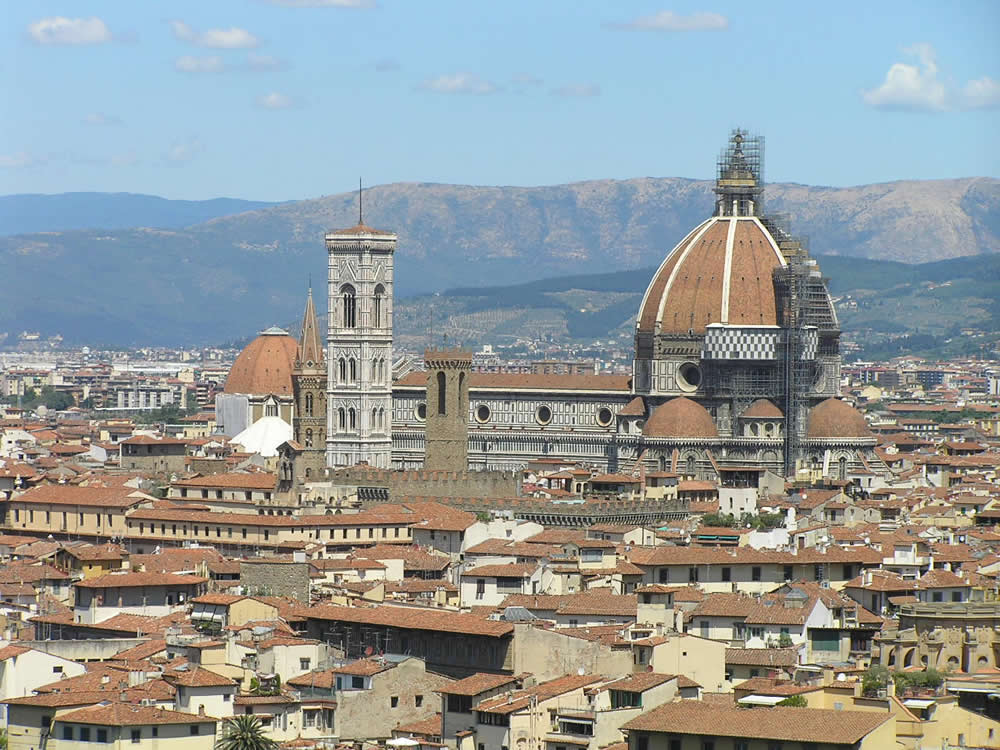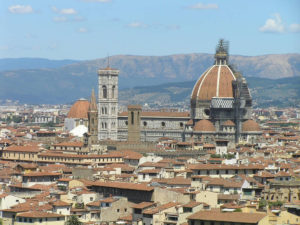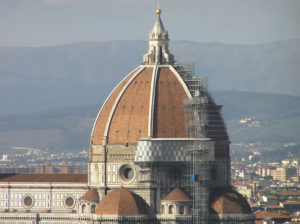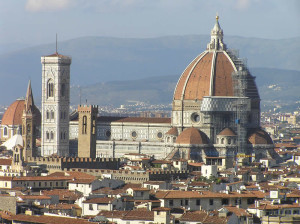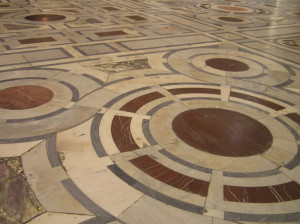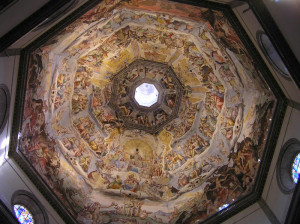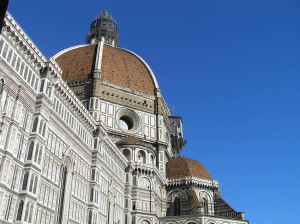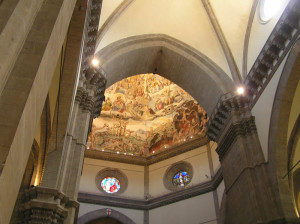Questo articolo è disponibile anche in:
![]() Français
Français ![]() Deutsch
Deutsch ![]() Español
Español ![]() Italiano
Italiano
The cathedral of Florence with its spectacular dome is together with the Ponte Vecchio, Palazzo Vecchio and the Uffizi the best known attraction in the city of Florence. Florence Cathedral has dominated the city skyline for hundreds of years. The dome above it is a unique work and an absolute masterpiece of architecture of all time.
The construction of the Florence Cathedral, the cathedral of Santa Maria del Fiore, was started by Arnolfo di Cambio on September 8, 1296. At the death of Arnolfo in 1310, work was progressing slowly, with considerable delays compared to the roadmap and at his death the work was stopped. The work was resumed again in 1331, when the merchants of the Wool Guild (Arte della Lana) took over the direction of the construction of the church.
Giotto’s appointment as master builder of the works took place in 1334. But he mainly participated in the construction of the bell tower (Giotto’s bell tower) due to his death after three years.
Subsequently, there were numerous interruptions until 1367 when a competition was launched which ended with the choice of a final model for the church proposed by four architects and four painters. The vault of the nave was finished in 1378 and the aisles themselves were completed in 1380.
Work on the stands and the dome shaft was carried out between 1380 and 1421. The octagonal dome, which consists of two concentric roofs connected together, was completed in 1436. A competition for the construction of the dome took place in 1418. Such competition ended, after much discussion, in 1420 with the choice of the project presented by Filippo Brunelleschi.
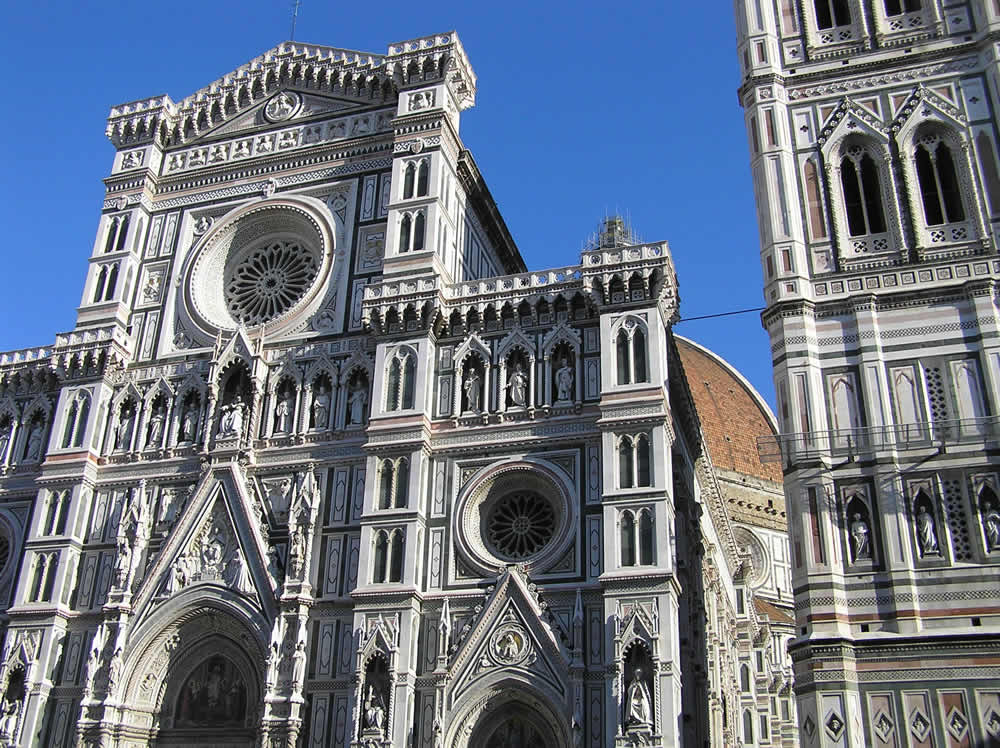
BRUNELLESCHI BUILDS THE DOME
Filippo Brunelleschi’s project for the dome of the cathedral of Santa Maria del Fiore in Florence remains one of the most important successes of Renaissance architecture. The dome was completed in 1436. This structure is above all a fundamental step of design and engineering, for its dimensions of over 45 meters in diameter it exceeds the domes of St. Paul’s Cathedral in London, and of St. Peter’s Basilica in Rome. In fact, this is the largest masonry dome ever built by man. This church, dedicated to Santa Maria del Fiore (flower refers to Florence) was consecrated on March 25, 1436.
The big difference between the styles present in the cathedral shows the change in taste during the long time spent in its construction. The external shape of the arches is above all a vestige of the Romanesque. While the interior of the cathedral, with its huge arches, doors and windows, is Gothic. The dome is the masterpiece of the Renaissance.
On the north side of the cathedral, the Porta della Mandorla, from the fifteenth century, shows Gothic influences both in design and decorations. The Gothic facade was built between 1871 and 1887 on a project by Emilio de Fabris. Its decoration recalls the Gothic one of Giotto’s bell tower and the side portals of the cathedral itself.
THE INTERIOR OF THE CATHEDRAL
The interior in the shape of a Latin cross is striking for the vastness of the space and the sobriety of the furnishings. Among the many works of art present in the cathedral, the most important are above all the frescoes of the dome representing the scenes of the Last Judgment, were made by Giorgio Vasari and Federico Zuccari between 1572 and 1579. The stained glass windows of the drum of the dome are works by Paolo Uccello, Donatello, Ghiberti and Andrea del Castagno. The marble choir (1547-1572) is the work of Baccio Bandinelli and Giovanni Bandini. Finally, the fifteenth-century windows of the chapels of the transept and presbytery are the work of Lorenzo Ghiberti.
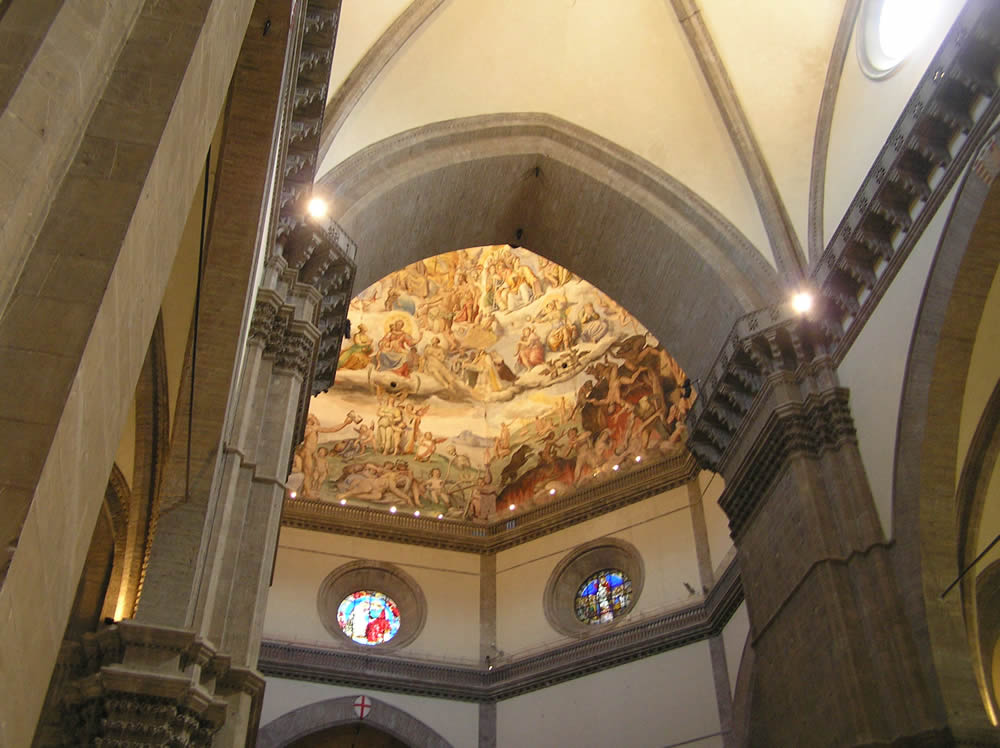
The Sacrestia Vecchia (Old Sacristy) and the Sacrestia delle Messe, both with above the door glazed terracotta of Luca della Robbia. While above the altar of the central chapel are other works in glazed terracotta by Luca della Robbia. The “Arca di San Zanobi” by Lorenzo Ghiberti. In the Sacristy of the Masses there are the Bronze Door (1445-1469) by Luca della Robbia, Michelozzo and Maso di Bartolomeo, and wonderful wooden marquetry work by Giuliano and Benedetto da Maiano based on drawings by Brunelleschi, Antonio del Pollaiolo etc … in the left nave are the panel “Dante and his worlds” by Domenico di Michelino, the equestrian monument to Giovanni Acuto, reworked by Paolo Uccello, and the equestrian monument to Niccolò da Tolentino, by Andrea del Castagno.
THE REMAINS OF THE ANCIENT CATHEDRAL OF SANTA REPARATA
Under the current cathedral are the remains of the ancient cathedral of Santa Reparata probably dating back to the fifth century AD. The ancient cathedral of Santa Reparata houses the tomb of Filippo Brunelleschi, discovered in 1972, the tombs of two popes (Stefano IX and Niccolò II), some bishops and other Florentine characters.
The church at the time of its completion, in the fifteenth century, was the largest in Europe and in the world. It measured 153 meters in length, 90 meters in width and 90 meters in height. Today the Duomo of Florence is the fourth church in the world after San Pietro in Rome, San Paolo in London and the Cathedral in Milan.
INFORMATION
Address: Piazza del Duomo Firenze Tel: 055 2302885 E-mail: opera@operaduomo.firenze.it
Opening Hours: Monday, Tuesday, Wednesday and Friday: 10.00 to 17.00. Thursday: May and October: from 10.00 to 15.30, from July to September: 10.00 to 17.00. Other months: 10.00 – 16.30. Saturday: 10.00 to 16.45. Sundays and religious holidays: 13.30 to 16.45.
Price: Free
Handicap access: YES
Questo articolo è disponibile anche in:
![]() Français
Français ![]() Deutsch
Deutsch ![]() Español
Español ![]() Italiano
Italiano

